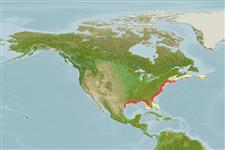Klassifizierung / Names
Namen | Synonyme | Catalog of Fishes (gen., sp.) | ITIS | CoL | WoRMS | Cloffa
Actinopterygii (Strahlenflosser) >
Perciformes (Perch-likes) >
Serranidae (Sea basses: groupers and fairy basslets) > Serraninae
Etymology: Centropristis: Greek, kentron = sting + Greek, pristis = saw (Ref. 45335).
Lebensraum / Klimazone / Range
Ökologie
; seewasser riff-verbunden; ozeanodrom (Ref. 51243); tiefenbereich 1 - ? m (Ref. 9988). Temperate, preferred 19°C (Ref. 107945); 45°N - 25°N
Western Atlantic: Canada (Ref. 5951) to Maine to northeastern Florida in USA and eastern Gulf of Mexico; reaches extreme southern Florida during cold winters.
Length at first maturity / Size / Gewicht / Alter
Maturity: Lm 19.1 range ? - ? cm
Max length : 66.0 cm TL Männchen/unbestimmt; (Ref. 40637); common length : 30.0 cm TL Männchen/unbestimmt; (Ref. 3708); max. veröff. Gewicht: 4.3 kg (Ref. 4699); max. veröff. Alter: 20 Jahre (Ref. 34089)
Commonly found around rock jetties and on rocky bottoms in shallow water. Marketed fresh and eaten fried, broiled and baked (Ref. 9988).
Life cycle and mating behavior
Geschlechtsreife | Fortpflanzung | Ablaichen | Eier | Fecundity | Larven
Also Ref. 32209, 103751.
Robins, C.R. and G.C. Ray, 1986. A field guide to Atlantic coast fishes of North America. Houghton Mifflin Company, Boston, U.S.A. 354 p. (Ref. 7251)
IUCN Rote Liste Status (Ref. 115185)
CITES (Ref. 94142)
Not Evaluated
Nutzung durch Menschen
Fischereien: kommerziell; Sportfisch: ja; Aquarium: Öffentliche Aquarien
Tools
Zusatzinformationen
Download XML
Internet Quellen
Estimates of some properties based on models
Phylogenetic diversity index (Ref.
82805): PD
50 = 0.5312 [Uniqueness, from 0.5 = low to 2.0 = high].
Bayesian length-weight: a=0.01259 (0.00742 - 0.02135), b=2.97 (2.82 - 3.12), in cm Total Length, based on LWR estimates for this species & (Sub)family-body (Ref.
93245).
Trophic Level (Ref.
69278): 3.9 ±0.2 se; Based on diet studies.
Widerstandsfähigkeit (Ref.
69278): mittel, Verdopplung der Population dauert 1,4 - 4,4 Jahre. (K=0.23-0.46; tmax=20).
Verwundbarkeit (Ref.
59153): Low to moderate vulnerability (31 of 100) .
